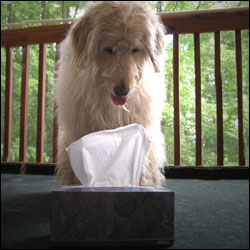Vaccines work by introducing the virus or bacteria to the body in a very small amount, so that the body's natural immune system will develop antibodies to the virus. Once your dog's body does this, if the actual virus or bacteria is contracted, your dog's body will recognize it as a threat and will respond with an immune response to eradicate it.
There are two main kinds of vaccines: Core (usually legally required) and Non-Core (optional)
Core vaccines include Distemper, Parvo, Canine Hepatitis, and Rabies.
Non-Core vaccines include vaccines against bacteria such as Bordetella bronchiseptica, Borrelia burgdorferi and Leptospirosis.
Core Vaccines:
Distemper is a virus with no known cure. It's similar to the measles virus in humans. Early symptoms of an infection are fever (103.5+), red eyes, watery discharge from nose and eyes, lethargy, and anorexia. persistent coughing, vomiting, or diarrhea are also common symptoms.
Parvovirus (parvo) is highly contagious and is dangerous, particularly to puppies and very old dogs. Poor appetite, vomiting, diarrhea (with or without blood) are common symptoms. Parvo can attack the heart muscle and bone marrow function as well, and is often lethal. Many shelters will euthanize dogs with Parvo instead of trying to treat it due to the high mortality rate and because it is highly contagious.
Canine Hepatitis can be fatal. It starts by causing an upper respiratory infection, and then attacks the liver, eyes, kidneys, and then the bloodstream. It's a nasty virus.
DAPPv is also known as the canine distemper combination. It is a four-way vaccine that protects against distemper, andenovirus (Canine Hepatitis), parvovirus, and parainfluenza. Vaccination should begin at 8 weeks of age. Boosters are given every 3-4 weeks until the puppy has reached 16 weeks of age or older. After the initial series the vaccine is boosted in one year, and every three years after that.
Rabies is often fatal, and is very serious. It affects the dog's central nervous system and gray matter of their brain. There are two kinds of rabies, furious and paralytic. Furious rabies includes the type of rabies you hear about or see on movies and features increased and overt aggression, biting Paralytic rabies is also sometimes called dumb rabies, and features loss of coordination and weakness. Furious rabies usually lasts a few days, followed by paralytic rabies. The virus moves quickly and early treatment is necessary for recovery. Rabies can be transmitted to humans and is very dangerous.
The Rabies vaccine can be administered to puppies as young as 3 months of age. It's usually recommended for a puppy to get a one year vaccine, followed by another one year vaccine, then a three year vaccine.
Non-Core Vaccines
Bordetella is also called kennel cough. Your dog will need this vaccine if she or he is going to be boarded at a canine daycare or boarding facility, or otherwise around other dogs. It's a highly contagious respiratory infection, with the most common symptom being a persistent cough. A dog with kennel cough may also have watery nasal discharge, and in cases that have been left untreated, symptoms can progress to pneumonia, fever, lack of appetite, lethargy, and death. Dogs often show symptoms 3-4 days after exposure.
The Bordetella vaccine for dogs is administered either as an injection under the skin or via nose drops every 6-12 months. A vaccinated dog may still contract Bordetella, but the case is often less severe. Most dogs can be vaccinated every 12 months, but your vet may recommend more often if your dog is frequently exposed to other dogs (such as those in dog daycare).
Borellia burgdorferi is also known as Lyme Disease and is spread by ticks, especially black legged ticks. Some Flea prevention products also work against ticks, as I talked about in this post about Flea & Tick prevention, but there is also a vaccine available. Lyme Disease causes joint pain (this may be lifelong!), tiredness, fever, and loss of appetite. There can also be less common symptoms like sudden onset lameness. My dog Otis had Lyme Disease when I adopted him, which is part of why flea and tick prevention is so important to me.
The Lyme Disease, or Borellia burgdorferi, vaccine is usually given in two doses the first time, with each dose two to four weeks apart and annual re-vaccination. Puppies must be at least 9 weeks old to receive the vaccine.
Leptospirosis is something I had not heard of before until a friend of
mine from Brazil told me how her dog had died from this, so I looked it up and
found out that this bacteria causes infections across the world, particularly
in warm and rainy areas, and is very serious. Common risk factors for leptospirosis in dogs
residing in the United States include exposure to or drinking from rivers,
lakes or streams, dogs that are around other dogs. Some infected dogs do
not show any signs of illness or infections, some have a mild and transient
illness and recover spontaneously on their own, while others develop severe
illness and death.
Signs of leptospirosis may include fever, shivering, muscle tenderness,
reluctance to move, increased thirst, changes in the frequency or amount of
urination, dehydration, vomiting, diarrhea, loss of appetite, lethargy,
jaundice (yellowing of the skin and mucous membranes), or painful inflammation
within the eyes. The disease can cause kidney failure with or without liver
failure. Dogs may occasionally develop severe lung disease and have difficulty
breathing. Leptospirosis can cause bleeding disorders, which can lead to
blood-tinged vomit, urine, stool or saliva; nosebleeds; and pinpoint red spots
(which may be visible on the gums and other mucous membranes or on
light-colored skin). Affected dogs can also develop swollen legs (from fluid
accumulation) or accumulate excess fluid in their chest or abdomen. Soon after this bacteria infects your dog, fever and
bacterial infection of the blood develops. The bacteria reproduces in the
liver, kidneys, central nervous system, eyes, and/or reproductive system.
While a healthy dog's immune system may be able to clear out most of the
infection, often some bacteria is left in the kidneys which then infect the
urine. This bacteria can be passed between dogs and animals. Dogs can become infected and develop
leptospirosis if their mucous membranes (or skin with any wound, such as a cut
or scrape) come into contact with infected urine, urine-contaminated soil,
water, food or bedding; through a bite from an infected animal; by eating
infected tissues or carcasses; and rarely, through breeding. It can also be
passed through the placenta from the mother dog to the puppies.
There is a Leptospirosis vaccine available, and it is adminstered annually. You may have to ask your vet for this vaccine, as they may not offer it to all dogs. If your dog is frequently around other dogs, or has access to woods or water (lakes, ponds, streams) you may want to seriously consider this vaccine.
Remember: An ounce of prevention is worth a pound of cure!
Source:
ASPCA
PetMD
PetsWebMD
VetStreet
AMVA
















